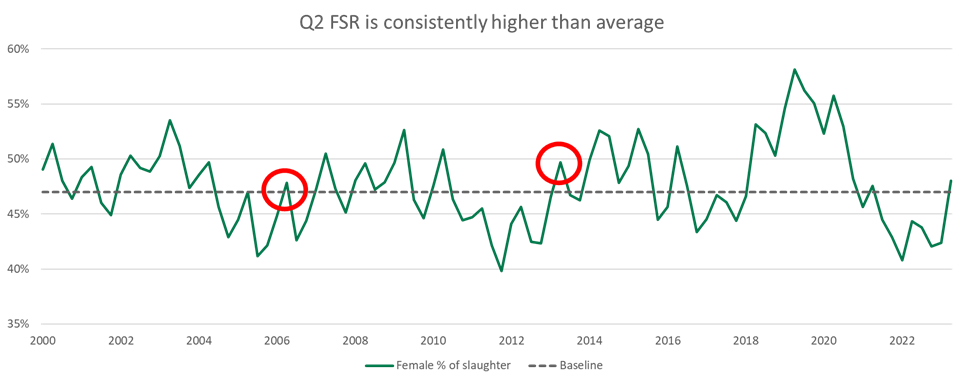Has the cattle herd begun to destock?
25 August 2023
Key points:
- Q2 ABS data shows a female slaughter rate (FSR) of 48%, above the long-term average of 47%
- Seasonal variation in slaughter patterns means that the FSR in Q2 is usually higher than average
- A more consistent trend will need to be established before making conclusions about the herd.
Production and slaughter statistics for the April-June quarter, released last week by the ABS, allow us to consider the industry's medium-term trajectory in light of new information.
One of the key figures for stakeholder participants to consider is the female slaughter rate (FSR), a technical indicator used to determine if a cattle herd is destocking or expanding. The indicator is very straightforward. If the number of cows and heifers slaughtered in a given period (expressed as a percentage of total slaughter) is higher than the long-run average (in this case, 47%), then the herd is judged to be in a destock.
By that measure, the April-June slaughter data showed Australia entering a destock for the first time since September 2021, with an FSR of 48%. While only marginally above the 47% cutoff point, this does mean that the Australian cattle herd has entered a technical destock.
With that said, a single datapoint does not determine the health of the industry more broadly, therefore the figure does not necessarily indicate that we are in a destock. Seasonal shifts in slaughter rates mean that the FSR can jump around over a year without necessarily indicating ‘real’ changes in the market.
Since 1990, the average FSR has been 47%, but the average FSR for the second quarter over that time has been 49.5%. That 2.5% variance means that in a ‘normal’ year where the FSR was 47% overall, you would actually expect the herd to enter a technical destock in Q2 with an FSR of between 49-50%.
This scenario has occurred several times since 2000. In 2006, 2013 and 2021, the FSR in Q2 jumped over 47% into destock territory before immediately dropping in Q2 back below 47%. We would typically judge those years as ‘rebuilding’ years and understand that the seasonal variation slaughter rates do not belie an underlying trend.

Source: ABS, MLA
The ABS accounts for this seasonal variation when publishing the data and releases a ‘seasonally adjusted’ data series alongside the actual figures. In this case, the seasonally adjusted figures give an FSR of 44%, below the actual 48% figure and below the 47% baseline.
This is not definitive, the herd could be beginning to destock as the rebuild matures and stocking rates reach cyclical peaks and the 48% FSR could be the first indication of that. However, given the seasonal variation in slaughter, it is too early to say if the herd has entered a destock, and we will need to wait for a consistent trend to develop to show that the Q2 data wasn’t a statistical fluke.


